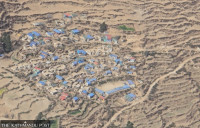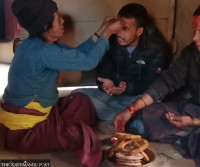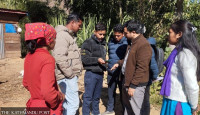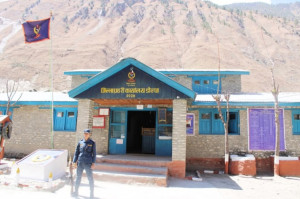Karnali Province
Long neglected, people of Humla see no point in cooperating to check virus spread
A week after 56 people were found to be infected, contact tracing has yet to begin. Winter brings seasonal flu, which has symptoms similar to Covid-19 and people may not be aware that they are carrying the coronavirus.
Arjun Poudel
Even a week after 56 persons, mostly students in three hostels, in Humla district tested positive for the coronavirus, contact tracing of over 40 people, who had come into their close contact, is yet to begin.
The people do not seem to have much faith in government efforts to improve their living conditions and have not been cooperative, according to health workers in the district.
Health workers at Namkha Rural Municipality, where the cases are, say people who came in close contact with the infected have refused to undergo tests.
“They instead questioned us about what they would do after knowing their infection status,” Gyachho Lama, the Covid-19 focal person for Namkha Rural Municipality, told the Post over the phone. “It is very difficult to convince the people to cooperate with health workers and undergo tests.”
People in Humla are deprived of most of the basic necessities, such as drinking water, basic health care services, nutritious food, sanitation and basic education. People are dying from easily treatable and preventable diseases, such as flu, asthma and diarrhoea.
According to the latest human development index report, Humla is among the most deprived districts in terms of health, education and sanitation. Life expectancy at birth in the district is only 58 years compared to the national average of 70 plus.
“There was no dearth of miseries in Humla, and now coronavirus has reached here,” said Lama. “Even if the people know about their disease status, they have nowhere to go and have to stay at home even if their health condition deteriorates.”
Namkha is the northernmost rural municipality of Humla, adjoining Tibet of China.
According to Lama, it takes three days on foot to reach Simikot, the district headquarters, from the affected villages in the summer.
Due to heavy snowfall, access to the district headquarters has at present been cut off. Even after reaching the district headquarters, it is very hard to get a hospital bed, as the district hospital has just 15 beds.
Therefore, they see no benefit in knowing about their disease status, said Lama.
To make matters worse, with the dip in temperatures, people have started getting sick from the seasonal flu. Every year, hundreds of people get infected and several of them succumb to it. Last year 10 people had died of seasonal flu.
“We know that already this year people in every household [in Namkha Rural Municipality] are affected by the seasonal flu right now,” Motilal Jaishi, an auxiliary health health worker serving in Humla told the Post over the phone. “But we don’t know if they are affected with the seasonal flu or the coronavirus, as we have not tested them.”
Most of the symptoms of seasonal flu match with those of the coronavirus.
According to a recent report, Prevalence of Selected Chronic Non-communicable Diseases in Nepal carried out by the Nepal Health Research Council, 25.1 percent population of Karnali region—the highest proportion in the country—suffers from chronic obstructive pulmonary diseases.
The study points at behavioural risk factors like tobacco use, and indoor pollution caused by burning firewood as the main culprits for the prevalence of the ailments in the region.
Doctors say those suffering from respiratory diseases are at great risk of dying, if infected with the coronavirus and during winter people remain indoors next to the fire inviting further risk.
Public health experts said that the situation has become really grim with the spread of the coronavirus to the remotest of places like Namkha in Humla.
“There are neither proper health facilities nor trained human resource in Humla,” Dr Prabhat Adhikari, an infectious disease and critical care expert, told the Post.
“Challenges have increased but it is also an opportunity to fix those weaknesses and therefore it is an opportunity for all three tiers of government to play their roles and fulfil their responsibilities.”
Doctors had recommended measures like imposing restrictions on public movement before Dashain to lessen the risk of spillover of the coronavirus from major hotspots like Kathmandu Valley, an increase in contact tracing and testing. The government, instead, stopped free testing and treatment for all. After the Supreme Court’s ruling, the government has reversed its decision but it seems to have come too late.
Given the health indicators in Humla, the spread of the virus is a double, if not triple, whammy.
According to the Nepal Demographic Health Survey 2016, the under-five mortality rate in Karnali region, where Humla falls, is 58 per 1,000 children, and 55 percent of the children suffer from stunting, which is double the national average.
The region is also the poorest and most food-insecure. Compared to the national average of 15 percent, there is 40 percent food insecurity in the Karnali region.
“Infected people in Kathmandu Valley are deprived of intensive care unit beds and ventilators,” Dr Mingmar Gyelgen Sherpa, former director general at the Department of Health Services, told the Post.
“We can only imagine the condition of Humla. And places like that are throughout the country.”
Apart from new challenges spelled by the coronavirus, there are alot of existing challenges—malnutrition, respiratory problems, lack of access to roads and a dearth of skilled workers, which were created due to the neglect of successive governments.
“Authorities should deploy health workers immediately in the disease hit villages and do their best to contain the further spread of infections,” said Sherpa. “As all people residing throughout the country have equal right to live, authorities should not differentiate and should be negligent in saving their lives.”
Sherpa said that the government should declare if it cannot do anything and seek national as well as international help to save lives.
Meanwhile, Dr Roshan Pokhrel, chief specialist at the Ministry of Health and Population, said that the ministry has requested the provincial government to deploy a team of health workers to the affected villages.
“We have also asked for setting up an isolation centre with about 40 beds and treating the patients in the respective places,” said Pokhrel. “We have directed officials to send two to three portable ventilators donated by the US government.”
But the reality on the ground is not as officials in Kathmandu imagine.
Health workers in Namkha said that a team of medics and doctors had reached the disease-hit villages and returned to the district headquarters after two days.
“People in our village generally do not seek treatment, as it is not easily available,” said a health worker from Nakha. “People here are not cooperating for tests, as they know that nothing will happen even after knowing their status. We know that death may come quickly here but not treatment.”




 5.14°C Kathmandu
5.14°C Kathmandu













